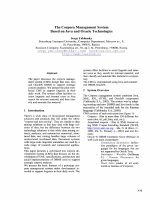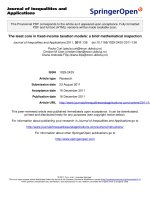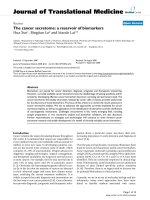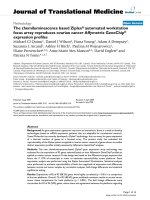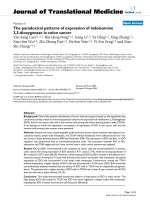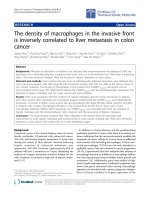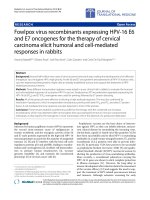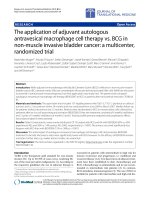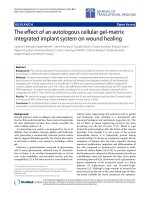báo cáo hóa học:" The Warwick-Edinburgh Mental Well-being Scale (WEMWBS): development and UK validation" potx
Bạn đang xem bản rút gọn của tài liệu. Xem và tải ngay bản đầy đủ của tài liệu tại đây (354.14 KB, 13 trang )
BioMed Central
Page 1 of 13
(page number not for citation purposes)
Health and Quality of Life Outcomes
Open Access
Research
The Warwick-Edinburgh Mental Well-being Scale (WEMWBS):
development and UK validation
Ruth Tennant
1
, Louise Hiller
1
, Ruth Fishwick
1
, Stephen Platt
2
,
Stephen Joseph
3
, Scott Weich
1
, Jane Parkinson
4
, Jenny Secker
5
and
Sarah Stewart-Brown*
1
Address:
1
Warwick Medical School, University of Warwick, Coventry, UK,
2
Research Unit in Health, Behaviour and Change, School of Clinical
Sciences & Community Health, University of Edinburgh, Edinburgh, UK,
3
School of Sociology & Social Policy, University of Nottingham,
Nottingham, UK,
4
NHS Health Scotland, Glasgow, UK and
5
Faculty of Health and Social Care, Anglia Ruskin University, Cambridge, UK
Email: Ruth Tennant - ; Louise Hiller - ; Ruth Fishwick - ;
Stephen Platt - ; Stephen Joseph - ; Scott Weich - ;
Jane Parkinson - ; Jenny Secker - ; Sarah Stewart-Brown* - sarah.stewart-
* Corresponding author
Abstract
Background: There is increasing international interest in the concept of mental well-being and its contribution to all aspects
of human life. Demand for instruments to monitor mental well-being at a population level and evaluate mental health promotion
initiatives is growing. This article describes the development and validation of a new scale, comprised only of positively worded
items relating to different aspects of positive mental health: the Warwick-Edinburgh Mental Well-Being Scale (WEMWBS).
Methods: WEMWBS was developed by an expert panel drawing on current academic literature, qualitative research with focus
groups, and psychometric testing of an existing scale. It was validated on a student and representative population sample.
Content validity was assessed by reviewing the frequency of complete responses and the distribution of responses to each item.
Confirmatory factor analysis was used to test the hypothesis that the scale measured a single construct. Internal consistency
was assessed using Cronbach's alpha. Criterion validity was explored in terms of correlations between WEMWBS and other
scales and by testing whether the scale discriminated between population groups in line with pre-specified hypotheses. Test-
retest reliability was assessed at one week using intra-class correlation coefficients. Susceptibility to bias was measured using
the Balanced Inventory of Desired Responding.
Results: WEMWBS showed good content validity. Confirmatory factor analysis supported the single factor hypothesis. A
Cronbach's alpha score of 0.89 (student sample) and 0.91 (population sample) suggests some item redundancy in the scale.
WEMWBS showed high correlations with other mental health and well-being scales and lower correlations with scales
measuring overall health. Its distribution was near normal and the scale did not show ceiling effects in a population sample. It
discriminated between population groups in a way that is largely consistent with the results of other population surveys. Test-
retest reliability at one week was high (0.83). Social desirability bias was lower or similar to that of other comparable scales.
Conclusion: WEMWBS is a measure of mental well-being focusing entirely on positive aspects of mental health. As a short and
psychometrically robust scale, with no ceiling effects in a population sample, it offers promise as a tool for monitoring mental
well-being at a population level. Whilst WEMWBS should appeal to those evaluating mental health promotion initiatives, it is
important that the scale's sensitivity to change is established before it is recommended in this context.
Published: 27 November 2007
Health and Quality of Life Outcomes 2007, 5:63 doi:10.1186/1477-7525-5-63
Received: 18 July 2007
Accepted: 27 November 2007
This article is available from: />© 2007 Tennant et al; licensee BioMed Central Ltd.
This is an Open Access article distributed under the terms of the Creative Commons Attribution License ( />),
which permits unrestricted use, distribution, and reproduction in any medium, provided the original work is properly cited.
Health and Quality of Life Outcomes 2007, 5:63 />Page 2 of 13
(page number not for citation purposes)
Background
There is increasing international interest in the concept of
positive mental health and its contribution to all aspects
of human life. The World Health Organisation [1] has
declared positive mental health to be the 'foundation for
well-being and effective functioning for both the individ-
ual and the community' and defined it as a state 'which
allows individuals to realise their abilities, cope with the
normal stresses of life, work productively and fruitfully,
and make a contribution to their community.' The capac-
ity for mutually satisfying and enduring relationships is
another important aspect of positive mental health [2].
The term positive mental health is often used in both pol-
icy and academic literature, interchangeably with the term
mental well-being. It is a complex construct, covering
both affect and psychological functioning with two dis-
tinct perspectives:- the hedonic perspective, which focuses
on the subjective experience of happiness and life satisfac-
tion, and the eudaimonic perspective, focusing on psy-
chological functioning and self realisation [3]. These
perspectives, which have informed distinct bodies of
research in positive mental health, are less obvious in the
literature relating to poor mental health, where items
measuring affect (feeling happy/sad) are often combined
with items measuring psychological functioning (playing
a useful part in things, making decisions) [4] in the same
scales, suggesting that poor mental health at least is
accepted as involving limitations in both eudaimonic and
hedonic well-being [5-7]. Positive mental health is recog-
nised as having major consequences for health and social
outcomes [8,9]. This has given rise to new positive psy-
chological therapies that are explicitly focused on facilitat-
ing positive mental health [10-12]. However the field of
positive mental health is under-researched partly because
of the lack of appropriate population-based measures
[13]. There is demand from those interested in public
mental health for a measure suitable for monitoring men-
tal well-being that does not show ceiling effects in popu-
lation samples. There is also demand from mental health
promotion practitioners for a measure with which they
can evaluate their programmes. Measures with a negative
focus can suggest to participants that such programmes
are for people with mental health problems and in this
way detract from, rather than support, these initiatives.
Existing instruments in this field take different conceptu-
alisations of well-being as their starting point. The com-
monly-used twenty-item PANAS scale [14] describes
affective-emotional aspects of well-being and is com-
prised of two dimensions: positive and negative affect
(PANAS-PA and PANAS-NA) which are reported as dis-
tinct and independent concepts. In contrast, the five-item
Satisfaction With Life Scale (SWLS) [15] aims to measure
cognitive-evaluative facets of well-being. The 54 item
Scale of Psychological Well-Being (SPWB) [16] focuses on
eudaimonic well-being and assesses psychological func-
tioning. Its sub-scales measure autonomy, self-acceptance,
environmental mastery, purpose in life, personal growth
and positive relations with others. The five-item Short
Depression-Happiness Scale (SDHS) [17] developed for
use in therapeutic settings assesses well-being as a contin-
uum between the two states of depression and happiness.
All these instruments cover aspects of mental illness as
well as mental health and include positive and negatively
worded items. The positively worded five item WHO
Wellbeing Index (WHO-5) [18] aims to measure overall
well-being and covers aspects of physical as well as mental
health.
We report here on the development and testing of a new
scale – the Warwick-Edinburgh Mental Well-Being Scale
(WEMWBS). This scale aims to build on previous scales
and capture a wide conception of well-being, including
affective-emotional aspects, cognitive-evaluative dimen-
sions and psychological functioning, in a form which is
short enough to be used in population-level surveys. By
focusing wholly on the positive, the scale is intended to
support mental health promotion initiatives and be free
of ceiling effects in population samples.
The starting point for the development of this scale was
the Affectometer 2 [19], a scale developed in New Zealand
in the 1980s which aimed to measure well-being and had
intuitive appeal to those working in mental health pro-
motion in the UK, because it covered both eudemonic
and hedonic aspects of mental health and had a good
range of positive items [20]. This scale comprised 20 state-
ments and 20 adjectives relating to mental health in
which positive and negative items are balanced. The UK
validation of Affectometer 2 reported good face validity,
favourable construct validity with comparable scales,
good discriminatory powers between different population
groups and appropriate test-retest reliability over time
[21,22]. The scale also had important limitations: its very
high level of internal consistency (r = 0.94) suggested
redundancy, its susceptibility to social desirability bias
was higher than that of other comparable scales and its
length was a potential barrier to its uptake as a measure of
population well-being. This study aimed to develop a new
scale of mental well-being with a single underlying con-
struct that encompassed a broad range of attributes asso-
ciated with mental well-being and to validate this scale
using data collected from student and population sam-
ples.
Methods
Participants and data collection – scale development
Nine focus groups were held, three in England and six in
Scotland. Participants were recruited through community
Health and Quality of Life Outcomes 2007, 5:63 />Page 3 of 13
(page number not for citation purposes)
groups, selected to cover a range of attributes (age, sex,
socio-economic status) that are known to be associated
with mental health [23]. In addition, one focus group was
carried out with mental health service users. Focus groups
were made up of a maximum of eight participants, and a
total of 56 people took part. Participants were asked to
complete the Affectometer 2, and to discuss their concept
of positive mental health and its relationship with items
in this scale. All focus groups were taped and transcribed.
Content analysis was used to identify items which partic-
ipants across the groups found consistently confusing or
difficult to understand and concepts relating to mental
well-being which participants thought should be included
in the scale. Full details of focus groups are reported else-
where [21]. Factor loadings and completion rates for indi-
vidual items from a general population survey were
examined for each of the Affectometer 2 items [22].
Development of WEMWBS
An expert panel representing the disciplines of psychiatry,
psychology, public health, social science and health pro-
motion with expertise in mental health and well-being
was convened to consider the results of the UK validation
of Affectometer 2 [21,22] and the analysis of focus group
discussions. With reference to current academic literature
describing psychological and subjective well-being, the
expert panel agreed key concepts of mental well-being to
be covered by the new scale: positive affect and psycholog-
ical functioning (autonomy, competence, self acceptance,
personal growth) and interpersonal relationships. Using
this framework and data from the qualitative and quanti-
tative studies described above, the panel identified items
for retention and rewording from Affectometer 2 and
agreed the wording of new items. A new scale composed
only of positively worded items relating to aspects of pos-
itive mental health was developed [see Additional file 1].
The final scale consisted of 14 items covering both
hedonic and eudaimonic aspects of mental health includ-
ing positive affect (feelings of optimism, cheerfulness,
relaxation), satisfying interpersonal relationships and
positive functioning (energy, clear thinking, self accept-
ance, personal development, competence and auton-
omy).
Individuals completing the scale are required to tick the
box that best describes their experience of each statement
over the past two weeks using a 5-point Likert scale (none
of the time, rarely, some of the time, often, all of the
time). The Likert scale represents a score for each item
from 1 to 5 respectively, giving a minimum score of 14
and maximum score of 70. All items are scored positively.
The overall score for the WEMWBS is calculated by total-
ling the scores for each item, with equal weights. A higher
WEMWBS score therefore indicates a higher level of men-
tal well-being.
Validation of WEWMBS
Participants and data collection – scale validation
Quantitative data were collected from two samples. Initial
scale testing was carried out using data collected from con-
venience samples of undergraduate and postgraduate stu-
dents at Warwick and Edinburgh universities. Students
were recruited from seven disciplines. Scales were admin-
istered at the end of scheduled teaching sessions. Partici-
pants were given the option of completing scale packs on
the spot or in their own time and were given a pre-
addressed envelope to return completed packs.
Students were asked to provide information on age, sex
and subject being studied, and to complete WEMWBS and
between two and four other scales each from a pool of
eight different scales. Scales were assigned randomly to
students, with WEWMBS either appearing at the begin-
ning or end of the sequence of scales. To assess the scale's
test-retest reliability, a random sub-sample of students
who had completed the scale pack was given the WEW-
MBS scale to complete one week later. Students were
asked to use a unique identifier on both occasions so that
data collected in the first week could be matched to data
collected one week later.
A second set of combined data from two representative
Scottish population datasets - the 2006 September wave
of the Scottish Health Education Population Survey
(HEPS) [24] and the 2006 Well? What do you think? Sur-
vey [25] - was used to test the results obtained from the
student sample, and to assess whether the scale discrimi-
nated between population groups in a way that was con-
sistent with the findings of national psychiatric morbidity
surveys [26].
Allowing for invalid addresses, a response rate of 66% was
achieved in HEPS and 57% in the Well? What do you
think? Survey, accruing 859 and 1,216 interviews respec-
tively. Interviews were carried out face to face, in people's
homes, using Computer Assisted Personal Interviewing.
NHS Health Scotland commissioned the HEPS which was
carried out by BMRB International and the Scottish Exec-
utive commissioned the Well? What do you think? survey
which was carried out by Ipsos MORI and Stirling Univer-
sity.
Statistical tests carried out on these two samples (student
and population) are summarised in Table 1. Only data
where WEMWBS was fully completed were used.
Unweighted data were used for the population sample.
Health and Quality of Life Outcomes 2007, 5:63 />Page 4 of 13
(page number not for citation purposes)
Validation measures
Eight additional scales were included in the student sam-
ple questionnaire to validate WEWMBS and one was
available in the population sample. These scales were cho-
sen to include those that measured either the same or sim-
ilar concepts to WEMWBS or concepts that were expected
to be associated with mental well-being such as emotional
intelligence and general health. Specific prior hypotheses
about the relationship between WEMWBS and each of the
eight scales were developed. The scales included two cov-
ering positive and negative aspects of affect (PANAS,
SDHS), one covering psychological functioning (SPWB),
one overall well-being (WHO-5), two scales measuring
life satisfaction (SWLS and the single-item Global Life Sat-
isfaction scale (GLS) [27]), and one scale, the 33-item
Emotional Intelligence Scale (EIS) [28] which consists of
statements covering appraisal, expression, and regulation
of emotion in self and others, and the utilisation of emo-
tions in problem solving. Information about health status
was assessed using the EuroQol Health Status Visual Ana-
logue Scale (EQ-5D VAS) [29] which asks respondents to
rate their overall health (physical as well as mental) on a
0–100 scale.
Data on mental ill-health was collected in the two popu-
lation datasets using the GHQ-12 [4] which asks partici-
pants about their general level of happiness, experience of
depressive and anxiety symptoms, and sleep disturbance
over the last four weeks. Other variables of interest were
collected in the two population datasets: data on sex, age,
housing tenure, self-perceived health status and employ-
ment status in both the HEPS and Well? What do you
think? Survey. In addition, the HEPS also collected data
on marital status, gross household income, age of leaving
formal education, and social grade of chief income earner.
Social desirability bias was assessed in the student sample
using the Balanced Inventory of Desirable Respose (BIDR)
[30] which includes sub-scales measuring impression
management and self-deception.
Content validity
The frequency of complete responses to WEMWBS from
both the student and population samples was examined
to assess the perceived relevance and adequacy of
WEMWBS to the target population. Using data from the
population sample, the demographics of complete
responders were compared to those who partially or non-
responded to the scale using Chi-square tests with conti-
nuity corrections and Chi-square tests for trend where
appropriate.
For assessment of relevance, sensitivity and signs of inap-
propriateness, the incidence of missing item responses
was considered. Additionally, the distributions of
responses from complete responders within the student
and population sample highlighted the frequency of pop-
ular responses and any floor and ceiling effects.
Table 1: Summary of psychometric tests carried out on two samples
Psychometric
property
Statistical test Student sample
(number)
Population sample
(number)
Content validity Responder bias: Chi-square tests - 2075
Missing and popular responses 348 2075
Floor/ceiling effects (individual items) 348 1749
Construct validity Confirmatory Factor Analysis 348 1749
Internal consistency Cronbach's α 's 348 1749
Item-total score correlations 348 1749
Criterion validity Floor and ceiling effects (total score) 348 1749
Demographic differences in scores: - 1749
Wilcoxon rank sum tests/Kruskal-Wallis tests/Jonckheere's test
Correlations with other scales:
Spearman's rank correlation coefficient 72 (EQ-5D VAS) 1233 (GHQ-12)
63 (PANAS- PA/NA)
63 (SPWB)
71 (SDHS)
79 (WHO-5)
79 (SWLS)
77 (GLS)
67 (EIS)
Jonckheere's test - 1233(GHQ-12)
Reliability Intra-class correlation coefficients 124 -
Social desirability bias Spearman's rank correlation coefficient 116 -
Health and Quality of Life Outcomes 2007, 5:63 />Page 5 of 13
(page number not for citation purposes)
Construct validity
Confirmatory factor analysis using weighted least squares
estimation was undertaken on item responses from both
the student and population samples to test the appropri-
ateness of the structural equation models that specified
the pre-hypothesised one-factor structure of WEMWBS.
Analysis was undertaken using the SAS statistical software,
initially assuming no dependencies between residuals and
then with stepwise addition of the matrix element repre-
senting the highest dependency until adequate fit statistics
were obtained.
The goodness of fit index (GFI) and adjusted goodness of
fit index (AGFI), based on a correction for degrees of free-
dom, were assessed with their desired levels being > 0.9
and > 0.8 respectively [31,32]. The Root Mean Square
Error of Approximation (RMSEA) was below the desired
0.06 level [33], thus indicating only a small amount of
unexplained variance or residual. The chi-squared statis-
tic, however, with a p-value < 0.05, indicates a significant
amount of actual covariance between measures that was
unexplained by the models [34]. However, large sample
sizesmay lead to an overstatement of lack of fit [32].
Internal consistency
Cronbach's alpha was calculated for each of the student
and population samples to measure the homogeneity of
the global score. Internal consistency estimates of > 0.70
were sought [35]. Additionally, to assess for item-redun-
dancy, Cronbach's alpha was calculated for different sized
reduced versions of the scale to identify at what point the
Cronbach's alpha would fall to an unacceptable level. For
each reduced size, 10 different choices of item compo-
nents were randomly chosen and the range of Cronbach's
alpha statistics was considered. For further assessment of
internal consistency, item-total score correlations,
adjusted for overlap, were calculated for each item; sub-
stantial but not excessive values (greater than or equal to
0.2 and less than 0.8) were sought [36].
Criterion validity
Total and item scores were examined for floor and ceiling
effects and the normality assumption investigated using
the Shapiro-Wilk test on both samples.
Correlations between scores on the WEMWBS and eight
other scales capturing different dimensions of physical
and mental health and well-being were calculated using
Spearman's rank correlation coefficients, using data from
the student sample. Population sample data were used to
generate Spearman's rank correlation coefficients and Jon-
ckheere's tests for ordered alternatives as appropriate for
WEMWBS scores and the scores generated from the GHQ-
12 [4]. Based on the content of each scale, we hypothe-
sised that WEMWBS would show high correlations with
scales capturing positive affect or well-being (SDHS,
WHO-5, PANAS-PA and SPWB) moderate correlations
with scales measuring physical or mental health status
(GHQ-12, EQ5D-VAS) and the PANAS-NA and lower cor-
relations with life satisfaction scales (GLS and SWLS) and
emotional intelligence (EIS).
Prior hypotheses about the expected association between
WEMWBS score and factors known to predict poor mental
health were developed. Based on the findings of recent
U.K. psychiatric morbidity studies [23,26], we hypothe-
sised that men would show a higher score than women,
that there would be no association with age at leaving full-
time education and that the scale would show a positive
association with higher socio-economic status. Differ-
ences in scores across demographic groups were assessed
for criterion validity using Wilcoxon rank sum tests,
Kruskal-Wallis tests and Jonckheere's tests for ordered
alternatives, as appropriate, using the population sample.
Social desirability bias was assessed on the basis of Spear-
man's rank correlation coefficients between WEMWBS
and scores on the impression management sub-scales of
the BIDR, using data from the student sample. For com-
parative purposes, correlations between the two BIDR
sub-scales and four other scales, (SWLS, WHO-5, PANAS-
PA and PANAS-NA, and single-item GLS) were also calcu-
lated.
Reliability
The scale's test-retest reliability at one week was assessed,
using intra-class correlation coefficients, using data col-
lected from a sub-sample of the student sample.
Ethics
This study was approved by Warwick Medical School's
Ethics Committee. Written consent for publication was
obtained from the participants.
Results
Response rates
In the student sample, 354 students from seven disci-
plines completed scale packs containing WEMWBS and
between two and four other scales. The overall response
rate was 53%. Of those who responded, 348 (98%) fully
completed WEMWBS. In the second week of testing (test-
retest reliability) 124 out of 266 (47%) students fully
completed WEMWBS.
In the population sample of size 2075, 323 (16%) failed
to answer any WEMWBS items and a further 3 responded
only partially. Partial or non-responders were more likely
to be older (p < 0.01), own their house outright or rent (p
< 0.01), be in worse general health (p < 0.01), be retired
(p < 0.01), have left education at an earlier age (p < 0.01)
Health and Quality of Life Outcomes 2007, 5:63 />Page 6 of 13
(page number not for citation purposes)
and have the chief household earner of a higher social
class (p < 0.0001) than complete responders. No differ-
ences were observed according to respondents' sex (p =
0.29), marital status (p = 0.38) or household income (p =
0.30).
Content validity
Assessment of item response frequencies from complete
responders in each sample showed little evidence of
highly skewed distributions, with all response categories
being used by at least one person for all items (Figure 1).
Construct validity
Confirmatory factor analysis of the 1749 respondent pop-
ulation sample showed the estimated factor matrix was
proven to match with the hypothesized factor matrix. The
GFI and AGFI were both above their desired levels (GFI =
0.91 and AGFI = 0.87). Additionally, the RMSEA = 0.0502
fell below the desired upper limit. Although the chi-
squared statistic indicated a significant lack of fit, the rel-
atively large sample size needs to be taken into considera-
tion when interpreting this finding. Confirmatory factor
analysis from the 348 respondent student sample showed
adequate GFI, AGFI and RMSEA value (GFI = 0.93, AGFI
= 0.89, RMSEA = 0.0551). A significant chi-squared statis-
tic was again obtained (chi squared = 141.6, df = 69, p <
0.0001). From these results, both samples showed verifi-
cation of the pre-hypothesised one-factor scale structure.
For each sample, all items loaded > 0.5 onto the single fac-
tor.
Internal consistency
The standardised Cronbach's alpha was 0.89 for the stu-
dent sample and 0.91 for the population sample, falling
well above the recommended lower limit. The standard-
ised Cronbach's alphas for the 10 randomly selected
reduced 13 item versions of the WEMWBS had ranges fall-
ing well above the 0.7 limit. Only when 6 items had been
deleted and 8 remained did the Cronbach's alpha fall
below even 0.8 for one of the 10 randomly selected ver-
sions of the scale in the student sample. Cronbach's alpha
remained above this level in the population sample until
8 items had been deleted (Figure 2).
WEMWBS scores were calculated for all responders. Item-
total correlations, corrected for overlap, for all items
ranged between r = 0.52 and 0.80 (student sample) and r
= 0.51 and 0.75 (population sample). These correlations
are within the desired limits, which supports the validity
of this global score.
Criterion validity
Although scale scores were reasonably Normally distrib-
uted, results in this large population sample showed sig-
nificant non-Normality (p < 0.01), with a slight negative
skew. WEMWBS score did not appear to suffer from floor
and ceiling effects in either sample (Figure 3).
The median score was 50 in the student sample and 51 in
the population sample, with inter-quartile ranges of 45 –
55 and 45 – 56 respectively.
In the student sample, overall health, as represented by
the EQ-5D VAS, showed a low to moderate significant cor-
relation (r = 0.43, p < 0.01), as hypothesised (Table 2).
Also as hypothesised, scales measuring components of
affect or well-being all showed significant high correla-
tions with WEMWBS: (PANAS-PA r = 0.71, p < 0.01, SPWB
r = 0.74, p < 0.01, SDHS r = 0.73, p < 0.01, WHO-5 0.77,
p < 0.01) (Table 2). A moderate negative correlation was
observed between WEMWBS and the PANAS-NA (r = -
0.54, p < 0.01) (Table 2). The two life satisfaction scales
showed higher than anticipated correlations with WEW-
MBS (SWLS r = 0.73, p < 0.01, GLS 0.53, p < 0.01) (Table
2). As hypothesised, the EIS showed a low to moderate
correlation with WEMWBS (r = 0.48, p < 0.01) (Table 2).
The WEMWBS score showed a significant moderate sized
negative correlation with mental ill-health, as represented
by GHQ-12 score, in the population sample (r = -0.53, p
< 0.01) using a Likert score, which persisted when a
dichotomous scoring method, (with the four GHQ
response categories being scored 0,0,1,1 [37]) was used (p
< 0.01) (Figure 4).
In the population sample, the median WEMWBS score
was significantly higher for men than for women (p <
0.05), as hypothesised (Table 3), and differences were
also observed across age groups (p < 0.01), with higher
scores observed in people aged 16–24 and 55–74.
WEMWBS score was associated with higher socio-eco-
nomic status as measured by both income levels and chief
income earner social grade (both p < 0.01), with scores
generally increasing as income or social grade increases.
We also observed statistically significant differences
between WEMWBS score and with housing tenure (p <
0.01) with higher scores among owner-occupiers. There
were significant differences in WEMWBS scores across lev-
els of marital status and employment status (both p <
0.01), with widowed, divorced or separated respondents
and unemployed respondents reporting low scores. Sig-
nificant differences were also observed with terminal age
of education (p < 0.05), although confidence intervals
overlapped for the < 16 and > 19 age groups. The highest
levels of mental well-being were observed in those who
had finished education at or older than 19 years of age
(Table 3). This differs from the results of population men-
tal health surveys [21].
Health and Quality of Life Outcomes 2007, 5:63 />Page 7 of 13
(page number not for citation purposes)
WEMBS question responses: student and population samplesFigure 1
WEMBS question responses: student and population samples.
,YHEHHQIHHOLQJFKHHUIXO
,YHEHHQLQWHUHVWHGLQQHZWKLQJV
,YHEHHQIHHOLQJORYHG
,YHEHHQDEOHWRPDNHXSP\RZQPLQGDERXW
WKLQJV
,YHEHHQIHHOLQJFRQILGHQW
,YHEHHQIHHOLQJFORVHWRRWKHUSHRSOH
,YHEHHQIHHOLQJJRRGDERXWP\VHOI
,YHEHHQWKLQNLQJFOHDUO\
,YHEHHQGHDOLQJZLWKSUREOHPVZHOO
,YHKDGHQHUJ\WRVSDUH
,YHEHHQIHHOLQJLQWHUHVWHGLQRWKHUSHRSOH
,YHEHHQIHHOLQJUHOD[HG
,YHEHHQIHHOLQJXVHIXO
,YHEHHQIHHOLQJRSWLPLVWLFDERXWWKHIXWXUH
3URSRUWLRQRIUHVSRQGHQWV
:(0:%6
T
XHVWLRQVVWXGHQWVDP
S
OH
,YHEHHQIHHOLQJFKHHUIXO
,YHEHHQLQWHUHVWHGLQQHZWKLQJV
,YHEHHQIHHOLQJORYHG
,YHEHHQDEOHWRPDNHXSP\RZQPLQGDERXW
WKLQJV
,YHEHHQIHHOLQJFRQILGHQW
,YHEHHQIHHOLQJFORVHWRRWKHUSHRSOH
,YHEHHQIHHOLQJJRRGDERXWP\VHOI
,YHEHHQWKLQNLQJFOHDUO\
3URSRUWLRQRIUHVSRQGHQWV
,YHEHHQGHDOLQJZLWKSUREOHPVZHOO
,YHKDGHQHUJ\WRVSDUH
,YHEHHQIHHOLQJLQWHUHVWHGLQRWKHUSHRSOH
,YHEHHQIHHOLQJUHOD[HG
,YHEHHQIHHOLQJXVHIXO
,YHEHHQIHHOLQJRSWLPLVWLFDERXWWKHIXWXUH
:(0:%6
T
XHVWLRQV
S
R
S
XODWLRQVDP
S
OH
Health and Quality of Life Outcomes 2007, 5:63 />Page 8 of 13
(page number not for citation purposes)
Cronbach's alphas of 10 randomly generated versions of WEMWBS: student and population samplesFigure 2
Cronbach's alphas of 10 randomly generated versions of WEMWBS: student and population samples.
0.78
0.8
0.82
0.84
0.86
0.88
0.9
0.92
012345678
9
Number of questions removed
Cronbach's alphas - student sample
Cronbach's alpha of full 14 question questionnaire = 0.89
0.78
0.8
0.82
0.84
0.86
0.88
0.9
0.92
0123456789
Number of questions removed
Cronbach's alphas - population sample
Cronbach's alpha of full 14 question questionnaire = 0.92
Health and Quality of Life Outcomes 2007, 5:63 />Page 9 of 13
(page number not for citation purposes)
Test-retest reliability
Test-retest reliability at one week in the student sample
was 0.83 (p < 0.01), indicating a high reliability for the
new scale.
Social desirability bias
Mean scores for the two sub-scales of the Balanced Inven-
tory of Desirable Response (impression management and
self-deception) were 6.7 (SD = 3.6) and 4.6 (SD = 3.2).
respectively, in the student sample. Correlations with
both the impression management and self-deception sub-
scales were similar to, or lower than, other comparable
scales and were lower than reported correlations with
Affectometer 2 [16] (Table 4), which suggests that the new
scale is not unduly susceptible to social desirability bias.
Discussion
The new 14-item scale appears to have good face validity,
as it covers the majority of the range of concepts associ-
ated with positive mental health, including both hedonic
and eudaimonic aspects, positive affect, satisfying inter-
personal relationships and positive functioning.
WEMWBS performs well against accepted criteria at a pop-
ulation level. Unlike other commonly-used measures of
mental health, WEMWBS did not show a ceiling effect in
either of the study populations, indicating that the meas-
ure may have potential for documenting overall improve-
ments in population mental well-being. The scale appears
to have good content validity: response rates were high in
both samples, although lower in the population sample
than in the student sample. Confirmatory factor analysis
supported the hypothesised one-factor solution, suggest-
ing that WEMWBS measures a single underlying concept.
The internal consistency of the scale was high in both
samples and only fell below a level of 0.8 once six items
had been deleted, suggesting some redundancy in the
scale. This may point to opportunities to reduce the length
of the scale still further.
WEWMBS appears to be less prone to social desirability
bias than other comparable scales assessed in this study.
The correlation between overall score and the impression
management sub-scale of the BIDR was lower than for any
of the other scales tested, with the exception of the posi-
Table 2: Correlations between WEMWBS and other scales:
student sample
Scale N Correlation with
WEMWBS
Overall health
EQ-5D VAS 72 0.43*
Well-being/affect
PANAS- PA 63 0.71*
PANAS- NA 63 -0.54*
Scales of Psychological Well-being 63 0.74*
Short Depression Happiness scale 71 0.73*
WHO-5 79 0.77*
Life satisfaction
Satisfaction with Life Scale 79 0.73*
Global Life Satisfaction 77 0.53*
Emotional intelligence
Emotional Intelligence Scale 67 0.48*
*p < 0.01
Score distribution for student and population samplesFigure 3
Score distribution for student and population samples.
%
WEMWBS score
Population sample
WEMWBS score
Student sample
%
Health and Quality of Life Outcomes 2007, 5:63 />Page 10 of 13
(page number not for citation purposes)
tive and negative sub-scales of the PANAS, although
WEMWBS was more prone to self-deception bias than
four of the other scales tested (SWLS, WHO-5, PANAS-NA
and GLS). However it out-performed Affectometer 2 on
both scales. This finding also needs to be reproduced in a
population sample.
This study has a number of limitations. Whilst consensus
is growing around many components of mental well-
being there is still debate about the relevance of some con-
cepts, for example spirituality and purpose in life. As
WEMWBS was developed to enable monitoring of popu-
lation health, it was considered important to cover only
items which were likely to receive endorsement from the
general UK population as related to mental well-being.
Items relating to spirituality were therefore not included.
The scale may need modification in the future to accom-
modate expansion of general population knowledge and
understanding relating to the core components of mental
well-being.
Although many of the tests for validity that were carried
out on the initial student sample were repeated with a
more robust population sample, space constraints meant
that it was not possible to include all eight scales used to
test the criterion validity of WEMWBS in this stage of the
research. The results from the student sample suggest that
WEWMBS shares common features with scales such as
WHO-5, the Short-Depression Happiness Scale, Satisfac-
tion with Life Scale and Scales of Psychological Well-
being. The single-item measure of life satisfaction and the
Emotional Intelligence Scale showed lower correlations,
suggesting that WEMWBS may be measuring a different
concept. However, these findings may not be generalisa-
ble to a wider population, given the limited age-range and
other characteristics of the student sample. Similarly, it
was only possible to assess the scale's test-retest reliability
on the student sample and at an interval of one week. Fur-
ther research is needed to identify whether this result is
reproducible in a population sample and to test the stabil-
ity of the scale over a longer period of time. In addition,
the scale's capacity to detect changes in mental well-being
at both individual and population-levels, for example
after a significant life event or intervention, has not yet
been assessed. This will be an important step in evaluating
the scale's suitability for use in evaluation studies using a
longitudinal design.
Conclusion
WEMWBS shows high levels of internal consistency and
reliability against accepted criteria. Short, acceptable and
meaningful to general population groups, and relatively
unsusceptible to bias, it is capable of distinguishing
between different population groups in a way that is con-
sistent with other population surveys. While the scale is
likely to appeal to those evaluating mental health promo-
tion initiatives (because of its positive focus), further
research is needed to ensure that the scale is sensitive to
change. The possibility that the scale could be shortened
further also needs exploration. In the meanwhile, the
scale's strong psychometric performance and lack of ceil-
ing effects suggests that it is suitable for use in measuring
mental well-being at a population level.
Abbreviations
BIDR Balanced Inventory of Desired Responding.
WEMWBS score vs. GHQ-12 score, scatter plot and box and 90% CI whisker plot: population sampleFigure 4
WEMWBS score vs. GHQ-12 score, scatter plot and box and 90% CI whisker plot: population sample.
Health and Quality of Life Outcomes 2007, 5:63 />Page 11 of 13
(page number not for citation purposes)
EIS Emotional Intelligence Scale
EQ-5D VAS EuroQol Health Status Visual Analogue Scale
GHQ-12 General Health Questionnaire
GLS Global Life Satisfaction
HEPS Health Education Population Survey
SDHS Short Depression Happiness Scale
SPWB Scale of Psychological Well-Being
SWLS Satisfaction with Life Scale
PANAS Positive And Negative Affect Scale
PANAS-PA Positive And Negative Affect Scale – positive
sub-scale
PANAS-NA Positive And Negative Affect Scale – negative
sub-scale
WHO-5 WHO Wellbeing Index
WEMWBS Warwick-Edinburgh Mental Well-being Scale
Competing interests
This research was commissioned by NHS Health Scotland.
Authors' contributions
RT designed and coordinated the study, carried out statis-
tical analyses and drafted the manuscript.
LH carried out all statistical analyses on population data-
sets and helped to draft the manuscript.
RF collected data, coordinated fieldwork and carried out
qualitative and statistical analyses.
Table 4: Social desirability correlations for included scales:
student sample
Scale N Impression
Management
Self-Deception
Affectometer 2 115 -0.25** 0.55**
Global Life Satisfaction 62 0.26* 0.13
Satisfaction with Life scale 62 0.34** 0.40**
PANAS-PA 52 0.02 0.50**
PANAS-NA 51 0.03 -0.16
WEMWBS 115 0.18* 0.35**
WHO-5 62 -0.39** -0.20
*p < 0.05
**p < 0.01
Table 3: WEMWBS scores across demographic groups:
population sample
Variable N Median
(95% CI)
p
Total 1749 51 (51–52)
Sex
Male 783 52 (51–52) < 0.05
Female 966 51 (50–52)
Age in years
16 – 24 176 53 (52–53) < 0.01
KW
25 – 34 245 51 (50–53)
35 – 44 353 51 (49–52)
45 – 54 306 50 (49–51)
55 – 64 334 52 (51–53)
65 – 74 274 52 (51–54)
75+ 61 51 (49–54)
Tenure
Own out right 523 52 (52–53) < 0.01
KW
Own with a mortgage 705 52 (51–52)
Rent 519 50 (49–51)
Self-perceived health status
Very good 563 54 (54–55) < 0.01
J
Good 753 51 (51–52)
Fair 319 47 (46–49)
Poor 84 44 (40–46)
Very poor 29 41 (36–47)
Employment Status ^
In work 968 52 (51–52) < 0.01
KW
Student 82 52 (50–54)
Retired 465 51 (50–52)
Unemployed 154 49 (47–51)
Other 79 46 (43–50)
Marital Status *
Single 188 51 (49–53) < 0.01
KW
Married/Living as couple 418 52 (51–53)
Widowed/Divorced/Separated 155 49 (46–51)
Gross household income, pa *
< £5000 55 48 (44–53) < 0.01
J
5000 – 14999 198 49 (47–51)
15000 – 29999 180 53 (51–54)
30000+ 173 51 (49–53)
Terminal Education Age *
< 16 228 52 (50–53) < 0.05
KW
16 – 18 355 50 (49–51)
19+ 181 53 (51–54)
Chief Income Earner Social Grade
*
A 38 55 (51–57) < 0.01
J
B8450 (48–53)
C1 217 51 (50–53)
C2 193 53 (51–54)
D 101 50 (47–52)
E 124 47 (44–51)
* Tests conducted on a reduced set of patients. Variable only
recorded in the HEPS survey.
95% CI = 95% confidence interval of the median
KW
= p-value generated from a Kruskal-Wallis test.
J
= p-value generated from a Jonckheere's tests for ordered
alternatives.
^ = test conducted excluding the Other category
Health and Quality of Life Outcomes 2007, 5:63 />Page 12 of 13
(page number not for citation purposes)
SP participated in the design and coordination of the
study, coordinated fieldwork and helped to draft the man-
uscript.
SJ participated in the design and coordination of the
study, advised on statistical analyses and helped to draft
the manuscript.
SW participated in the coordination of the study and
helped to draft the manuscript.
JP commissioned the study, participated in its design and
coordination and helped to draft the manuscript.
JS advised on qualitative analyses and participated in the
coordination of the study.
SS-B conceived of the study, coordinated the development
of the instrument and helped to draft the manuscript.
All authors read and approved the final manuscript.
Additional material
Acknowledgements
NHS Health Scotland commissioned the HEPS which was carried out by
BMRB International and the Scottish Executive commissioned the Well?
What do you think? survey which was carried out by Ipsos MORI and Stir-
ling University.
References
1. World Health Organisation: Promoting Mental Health; Concepts emerg-
ing evidence and practice. Summary report Geneva; World Health
Organisation; 2004.
2. World Health Organisation: Strengthening mental health promotion
Geneva; World Health Organisation; 2001.
3. Ryan RM, Deci EL: On happiness and human potential: a review
of research on hedonic and eudaimonic well-being. Annu Rev
Psychol 2001, 52:141-166.
4. Goldberg DP, Williams P: A user's guide to the General Health Question-
naire Windsor, UK: NFER-Nelson; 1988.
5. Compton WC, Smith ML, Cornish KA, Qualls DL: Factor structure
of mental health measures. J Pers Soc Psychol 1996, 71:406-413.
6. Keyes CLM, Shmotkin D, Ryff CD: Optimizing well-being: The
empirical encounter of two traditions. J Pers Soc Psychol 2002,
82:1007-1022.
7. Waterman AS: Two conceptions of happiness: Contrasts of
personal expressiveness (eudaimonia) and hedonic enjoy-
ment. J Pers Soc Psych 1993, 64:678-691.
8. Huppert FA, Wittington JE: Positive mental health in individuals
and populations. In The Science of Well-being Edited by: Huppert FA,
Baylis N. Keverne Oxford: Oxford University Press; 2004:307-340.
9. Linley PA, Joseph S, (Eds.): Positive psychology in practice.
Hoboken, NJ: Wiley; 2004.
10. Fava GA: Well-being therapy. Psychother Psychosom 1999,
68:171-178.
11. Fava GA, Rafanelli C, Cazzarro M, Conti S, Grandi S: Well-being
therapy: A novel psychotherapeutic approach for residual
symptoms of affective disorders. Psychol Med 1998, 28:475-480.
12. Joseph S, Linley PA: Positive therapy: a meta-theory for posi-
tive psychological practice. Routledge; 2006.
13. Hu Y, Stewart-Brown S, Twigg L, Weich S: Can the 12 item Gen-
eral Health Questionnaire be used to measure positive men-
tal health? Psychol Med 2007, 37(7):1005-13.
14. Watson D, Clark LA, Tellegen A: Development and validation of
brief measures of positive and negative affect: the PANAS
scales. J Pers Soc Psych 1988, 6(54):1063-70.
15. Diener E, Emmons RA, Larsen RJ, Griffin S: The Satisfaction with
Life Scale.
J Pers Assess 1985, 49(1):71-75.
16. Ryff CD, Keyes CLM: The structure of psychological well-being
revisited. J Pers Soc Psychol 1995, 69:719-727.
17. Joseph S, Linley PA, Harwood J, Lewis CA, McCollam P: Rapid
assessment of well-being: the Short Depression-Happiness
Scale (SDHS). Psychol Psychother 2004, 77:463-478.
18. Bech P: Measuring the dimensions of psychological general
well-being by the WHO-5. QoL Newsletter 2004, 32:15-16.
19. Kammann R, Flett R: A scale to measure current level of gen-
eral happiness. Aust Psychol 1983, 35:259-265.
20. Stewart-Brown S: Measuring parts most measures do not
reach: a necessity for evaluation in mental health promotion.
J Mental Health Promotion 2002, 1:4-9.
21. Tennant R, Fishwick R, Platt S, Joseph S, Stewart-Brown S: Monitor-
ing positive mental health in Scotland: validating the Affec-
tometer 2 scale and developing the Warwick-Edinburgh
Mental Well-being Scale for the UK. Edinburgh, NHS Health
Scotland; 2006.
22. Tennant R, Joseph S, Stewart-Brown S: The Affectometer 2: a
measure of positive mental health in UK populations. Qual
Life Res 2007, 16(4):687-695.
23. Singleton HLG, (Ed): Better or worse: a longitudinal study of
adults living in private households in Great Britain. London:
The Stationery Office; 2003.
24. NHS Health Scotland: Health Education Population Survey:
Update from 2006 survey. Glasgow: NHS Health Scotland (in prep-
aration) [database on the Internet] 2007 [a-
archive.ac.uk]. Colchester: UK Data Archive
25. Braunholtz S, Davidson S, Myant K, O'Connor R: Well? What do
you think? (2006) The third national Scottish survey of public
attitudes to mental health, mental wellbeing and mental
health problems. Scottish Executive: Edinburgh; 2007. To access
the dataset contact Angela Hallam Angela.Hallam@scot-
land.gsi.gov.uk
26. Singleton N, Bumpstead R, O'Brien M, Lee A, Meltzer H: Psychiatric
morbidity among adults living in private households. Office for
National Statistics: London 2001.
27. Eurobarometer Life Satisfaction [ />public_opinion]
28. Schutte NS, Malouff JM, Hall LE, Haggerty DJ, Cooper JT, Golden CJ,
Dornheim L: Development and validation of a measure of
emotional intelligence. Pers Ind Diff 1998, 25:167-177.
29. Brooks R, Robin R, de Charro F, (Eds.): The measurement and valuation
of health status using EQ5-D: a European perspective Kluwer Academic
Publishers; 2003.
30. Paulhus DL, Reid DB: Enhancement and denial in socially desir-
able responding. J Pers Soc Psychol 1991, 60:307-317.
31. Bentler PM: Comparative fit indexes in structural models. Psy-
chol Bull 1990, 107(2):238-246.
32. Cole DFA: Utility of confirmatory factor analysis in test vali-
dation research. J Consul Clin Psychol 1987, 55:584-594.
33. Hu L, Bentler PM: Cutoff criteria for fit indexes in covariance
structure analysis: Conventional criteria versus new alterna-
tives. Structural Equation Modeling 1999, 1:1-55.
34. Bentler PM, Bonnet DG: Significance tests and goodness of fit in
the anlaysis of covariance structures. Psychol Bull 1980, 88:58.
35. Nunnally JC: Psychometric Theory. 2nd edition. McGraw-Hill,
London; 1978.
36. Cheung WY, Garratt AM, Russell IT, Williams JG: The UK IBDQ –
A British version of the inflammatory bowel disease ques-
Additional file 1
The Warwick-Edinburgh Mental Well-being Scale. The fourteen-item
Warwick-Edinburgh Mental Well-being Scale.
Click here for file
[ />7525-5-63-S1.pdf]
Publish with Bio Med Central and every
scientist can read your work free of charge
"BioMed Central will be the most significant development for
disseminating the results of biomedical research in our lifetime."
Sir Paul Nurse, Cancer Research UK
Your research papers will be:
available free of charge to the entire biomedical community
peer reviewed and published immediately upon acceptance
cited in PubMed and archived on PubMed Central
yours — you keep the copyright
Submit your manuscript here:
/>BioMedcentral
Health and Quality of Life Outcomes 2007, 5:63 />Page 13 of 13
(page number not for citation purposes)
tionnaire: development and validation. J Clin Epidemiol 2000,
53(3):297-306.
37. Goldberg DP, Gater R, Sartorius N, Ustun TB, Piccinelli M, Gureje O,
Rutter C: The validity of two versions of the GHQ in the
WHO study of mental illness in general health care. Psychol
Med 1997, 27:191-197.
